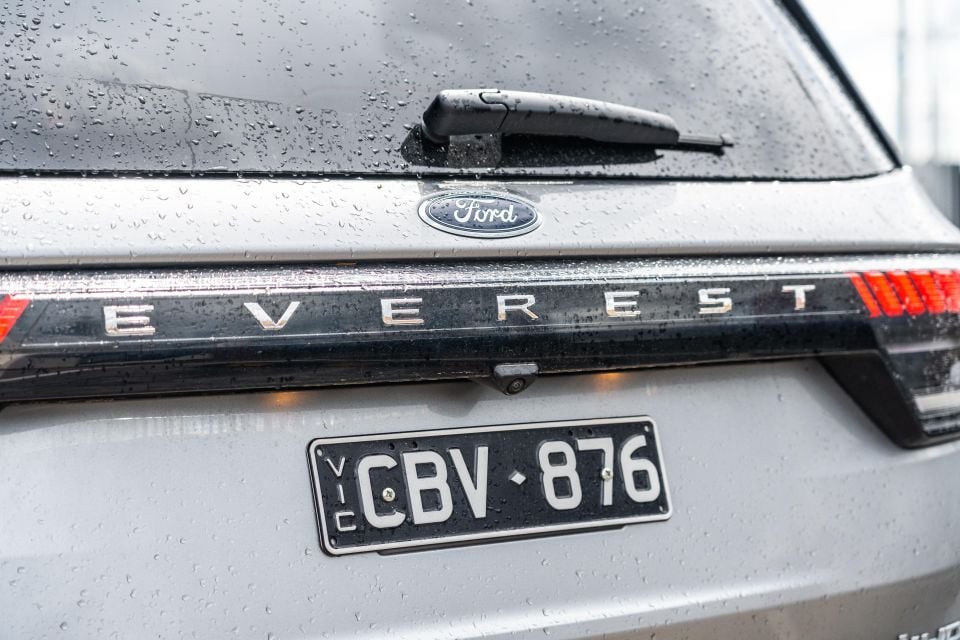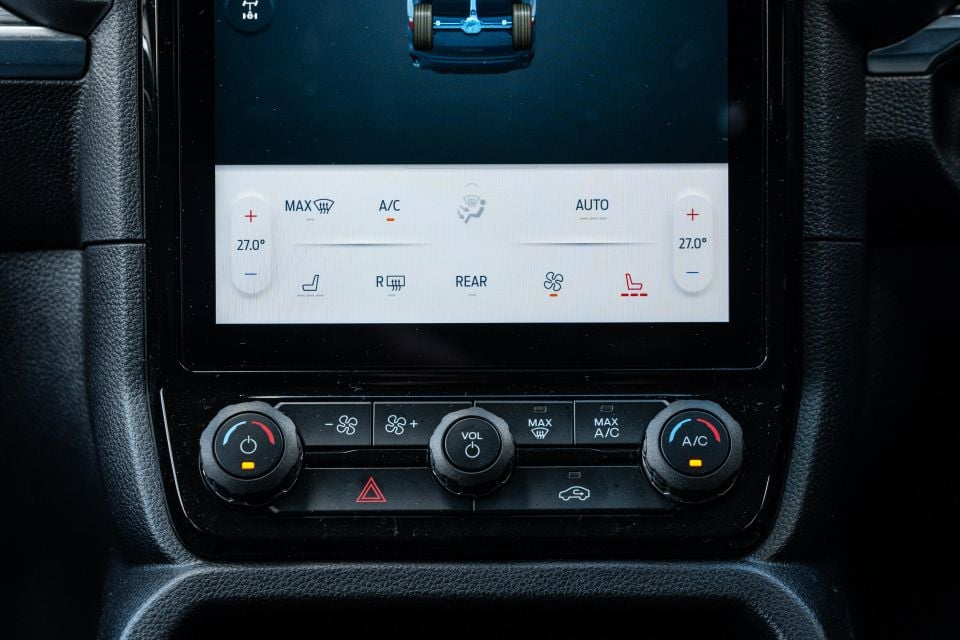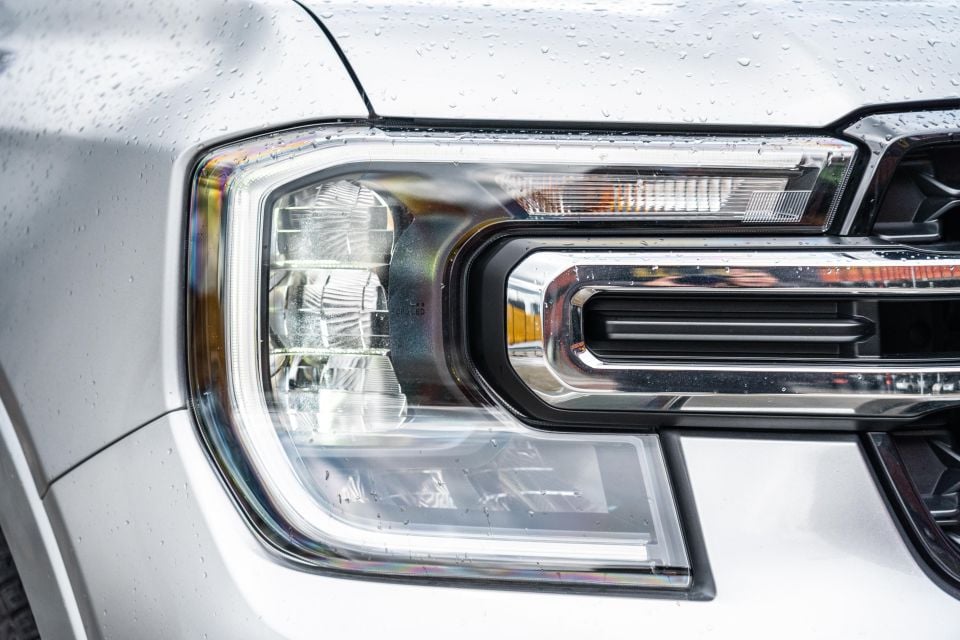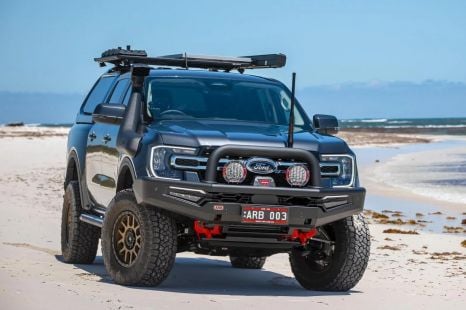

Matt Campbell
2026 Hyundai Palisade Calligraphy Hybrid AWD review
2 Days Ago
Guest User
My dashboardFord's Everest continues to 'trend' upwards in the eyes of critics and the sales charts – and this one-up from base 4x4 makes it clear why.



Quickly see how this car stacks up against its competition. Select any benchmark to see more details.
Where expert car reviews meet expert car buying – CarExpert gives you trusted advice, personalised service and real savings on your next new car.
Ever been stuck in your sibling’s shadow? Well, the Ford Everest can relate.

Long a top pick in the large ute-base 4×4 segment, the Everest has forever played a distant second fiddle to the related Ranger pick-up on the sales charts, up until quite recently.
The “Next-Gen” Everest, which launched around July-August 2022, set a number of sales records last year and has the Blue Oval firmly in contention for segment sales leadership. Going into 2023, a full year of deliveries could prove to be a turnaround for this off-road-capable seven seater.
Here on test we have the one-up-from-base 2023 Ford Everest Trend Bi-Turbo with the optional 4×4 system – arguably, the only way to have the Everest anyway to make the most of its capabilities. Could this be the sweet spot in the range?
The Ford Everest range opens at $53,290 plus on-road costs for the base Ambiente 4×2, but the Trend 4×4 on test is a bit dearer starting at $65,590 before on-roads.
You can get the Everest Trend Bi-Turbo as a 4×2 for $60,590 – though if you have any intentions of going off-road we’d suggest the all-paw model is the one to buy.
Despite the Trend being one-up from base trim in the Everest family, it’s priced in line with high-spec versions of most direct competitors.
An Isuzu MU-X LS-T will set you back $65,990 drive-away, while the Mitsubishi Pajero Sport GSR 4WD is currently available at $65,490 drive-away.
Even the Toyota Fortuner Crusade flagship is more affordable at $62,945 plus on-roads; while the top-selling LandCruiser Prado in mid-spec GXL flavour is priced from $67,530.

2023 Ford Everest pricing:
Prices include luxury car tax if applicable, but exclude on-road costs
Buy your new car without the stress. It's fast, simple and completely free.

Great service from Travis and team, second time I have used this business would not hesitate to recommend them to anyone
Craig C.
Purchased a Ford Ranger in Sunshine Coast, QLD
CarExpert helped Craig save thousands on his Ford Ranger, now let us save you on your next new car.
Find a dealWhile it’s only one-up from base level, Ford has done a great job at making the Everest Trend’s interior competitive at this price point.

The Trend upgrades to the larger 12-inch central infotainment system over the Ambiente’s ‘basic’ 10-inch unit, and the soft-touch door tops and leather-accented trim really lift the ambience over said Ambiente.
Ahead of the driver is the 8.0-inch digital instrument cluster that’s common to all variants bar the top-spec Platinum, and the leather-trimmed multifunction steering wheel looks good and feels good in the hand.
As we’ve covered previously, Ford’s display tech is top of the class, no question.


The 12-inch Sync 4 infotainment unit offers largest-in-class display real estate, arguably class-leading usability and response, and is well-featured. Wireless smartphone mirroring, embedded satellite navigation with online updates, voice control and DAB radio cover all bases.
In practice the screen is quite easy to use, and everything works as it should. Wireless Apple CarPlay worked the first time, every time with my iPhone 14 Pro Max, while the screen is quick to respond to touch inputs and the menus are all logically laid out.
Props to Ford for including both virtual and physical climate controls, allowing you to use the base of the screen to toggle temperature or the knobs underneath. It avoids you being limited to touch functionality, which can be a little clumsy if you need to adjust things on the move.


The basic 8.0-inch digital instrument cluster is a little spartan for my liking, and I wish there was the option to upgrade to the Platinum’s excellent 12-inch unit. But, it does the job and has a few different widgets and menus you can shuffle through.
Comfort up front is excellent, with the driver’s seat also power adjustable six ways. The leather-accented trim is hardy but doesn’t feel like toad skin, and there’s plenty of space giving and airy feel.
Storage is likewise very good. There are plenty of nooks in the centre console for loose items, as well as a wireless smartphone charging pad. The door pockets are a little skinny for a car this large and rugged, though the huge centre bin under the padded armrest sort of makes up for it.




Rear seat space has improved over the previous generation, and the elevated theatre-style seating means little ones will have a good view out – no more emergency stops for car sickness.
Leg, head and knee room are all plentiful even if you’re over six-foot like myself, and if you can squeeze three across for shorter journeys. I will note the large driveline hump in the floor eats into foot room, however.
While there isn’t a third zone of climate control, there is a manual fan control to toggle the air speed through the roof-mounted air vents in the second and third rows, which is handy to have. Behind the centre console is also a module with USB-A and USB-C outlets to keep phones and iPads juiced.
Other rear seat amenities include map pockets behind the front seatbacks, a fold-down centre armrest with cupholders, bottle holders in the doors, as well as the requisite ISOFIX window seat anchors and top-tether points across all three rear seats.




Access to the third row is via folding and sliding the second row forward, but it’s not quite as easy to get in as it is in something like a Kia Sorento or Mazda CX-9. Once you’re back there it’s more than kid friendly, and you can probably pinch some adults in there for a shorter journey.
Air vents feature back there, along with 12V ports, and the curtain airbags cover all three rows of seating. Big windows are also a plus.
Behind the third row, there’s 259L of cargo space, expanding to 898L with it folded and 1823L with the second row folded. With all three rows up, you can fit either some small bags or perhaps one suitcase, pending size.
The Everest Trend is exclusively offered with the 2.0-litre Bi-Turbo four-cylinder diesel, tested here with the optional full-time 4×4 drivetrain.

Outputs for the four-pot oiler are rated at 154kW (3750rpm) and 500Nm (1750-2000rpm), with drive channelled to that aforementioned full-time 4×4 system via a standard 10-speed automatic transmission.
As noted earlier, you can save $5000 and get the Trend-spec as a 4×2 which drives the rear wheels only. Otherwise, the engine specs and transmission are the same.
Further up the range, in Sport and Platinum grades, you can also choose from a beefier 184kW/600Nm 3.0-litre V6 turbo-diesel.
Ford quotes combined fuel consumption of 7.2 litres per 100km, with the fuel tank measuring 80 litres in capacity. The engine is Euro 6 certified, and features idle stop/start tech and AdBlue injection.
The Everest is rated to tow up to 3500kg with a braked trailer. Kerb weight for this variant is listed as 2383kg, while gross vehicle mass (GVM) is rated at 3100kg and gross combination mass (GCM) is 6250kg.
As we’ve found in previous Everest reviews, this latest generation is a huge step forward for ute-based SUVs.

The latest Everest (and Ranger for that matter) transcend their workhorse underpinnings to offer luxury SUV levels of comfort and refinement on the road. Moreso the Everest, given its more pliant coil-spring rear suspension.
Fire it up and the Bi-Turbo diesel puts out a subdued diesel clatter that’s typical of smaller-capacity oilers, though it’s never to the point where you’d consider it unrefined – particularly against its competition.
In town the 2.0-litre diesel hardly feels underpowered, with enough torque and gear ratios to get along effortlessly.
The 10-speed automatic is a noticeable improvement over the preceding Everest, which doesn’t sound like it’s constantly hunting for the right gear, and offers crisper upshifts under acceleration – the old one would at times sound like a CVT.

Comfort in the Everest Trend is another strong point in the city, thanks to its smaller 18-inch wheels and chubby tyres. It irons out the lumps and bumps of urban and inner-city roads with aplomb, and doesn’t suffer much wallowing or clumsy body control that some vehicles in this segment do.
Light steering and good outward visibility also make this big bus that little bit easier to place in tight streets and car parks, though there’s no escaping its lofty ride height and hefty exterior dimensions – remember the Everest measures 4914mm long and 2207mm wide.
Our test car was also fitted with the $2300 Touring Pack, which adds trailer coverage for the blind-spot monitoring and rear cross-traffic alert systems, along with a surround-view camera system. It’s a shame the cameras aren’t standard given the price point, but nevertheless they add to an already well-rounded package and further aid outward visibility.
In terms of refinement, the Everest’s cabin is a pretty quiet place to spend time regardless of whether you’re putting around the ‘burbs or touring an interstate highway – even on our test car’s optional all-terrain tyre package.

The more rugged rubber transmits faint tyre roar into the cabin, but it’s arguably quieter at speed than some premium-badged compact passenger vehicles that retail for similar money.
Speaking of the highway, the 10-speed auto and 2.0-litre Bi-Turbo diesel hum away almost silently in the background at a cruise, making the Everest a fantastic cross-country tourer.
The ride is settled and compliant over undulations, road and wind noise are kept to impressive levels, and the array of standard driver assistance systems take the load off extended stints behind the wheel.
I’m a big fan of Ford’s adaptive cruise control and active lane guidance assists, which help keep the big Ford on the straight and narrow. They’re well calibrated too, so you don’t feel like you’re wrestling with the car for control of the steering wheel.




Off-Road
Paul Maric took the Everest Trend 4×4 off-road as part of the attached video review, and commented on the impressive off-road tech including the helpful displays in the instrument cluster, as well as the various drivetrain modes.
Thanks to its intuitive traction control, 4×4 driveline and optional all-terrain rubber, the Everest Trend performed well across all the usual CarExpert 4×4 challenges, including the offset moguls, hill climb and descent, water crossing, and rock test.
In Trend spec, the Everest boasts a lofty 226mm of ground clearance; approach, departure and breakover angles are 30.2, 25 and 21.9 degrees respectively, and there’s a locking rear differential. Also standard is a well-calibrated hill descent control – as Paul demonstrates in the video up top.
Ford also quotes a wading depth of 800 millimetres. Watch the video above for more.
Everest Ambiente highlights:




Where expert car reviews meet expert car buying – CarExpert gives you trusted advice, personalised service and real savings on your next new car.


Everest Trend adds:
The Ford Everest earned a five-star safety rating in ANCAP testing, which applies to all variants.

It scored 86 per cent for adult occupant protection, 93 per cent for child occupant protection, 74 per cent for vulnerable road user protection, and 86 per cent for safety assist.
The five-star rating is based on tests carried out on the closely related Ford Ranger ute. For owners of cars built before August 20, 2022, that rating only applies once a software update has been installed by a dealer.
Standard safety equipment includes:
Like the wider Ford line-up, the Everest is backed by a five-year, unlimited-kilometre warranty.

Ford Australia also includes roadside assistance and Auto Club membership for up to seven years.
Maintenance is required every 12 months or 15,000 kilometres – whichever comes first. The first four services (up to 60,000km) are priced at $329 under the Blue Oval’s capped-price service program.
As for real-world fuel consumption, we ended our week (over 520km) with an indicated 10.1L per 100km which is well up on the brand’s 7.2L/100km claim.
Worth noting is the fact we spent much of our time behind the wheel commuting to and from the office, as well as running errands around town.
It’s very easy to be drawn to the blacked-out Sport or glossy Platinum grades, but the humble Trend spec has quite a lot going for it.

While being one-up from base, the Trend can be specified to the same levels as high-spec rivals for similar money, and the ‘entry-level’ 2.0-litre Bi-Turbo diesel is more than a match for rival motors – though a V6 option would be nice.
As we’ve detailed in this review, the Next-Gen Everest range brings class-leading tech and driving refinement to a segment often regarded as fairly agricultural alternatives to unibody SUVs like the Kia Sorento, Mazda CX-9 and Toyota Kluger.
Now, you can have proper off-road and towing capability without sacrificing the comfort and refinement you’d expect in more road-biased SUVs. The Everest can really do it all.

Click the images for the full gallery
MORE: Everything Ford Everest
Where expert car reviews meet expert car buying – CarExpert gives you trusted advice, personalised service and real savings on your next new car.
James Wong is an automotive journalist and former PR consultant, recognised among Australia’s most prolific motoring writers.


Matt Campbell
2 Days Ago


William Stopford
8 Days Ago


William Stopford
8 Days Ago


Ben Zachariah
10 Days Ago


William Stopford
14 Days Ago


William Stopford
16 Days Ago